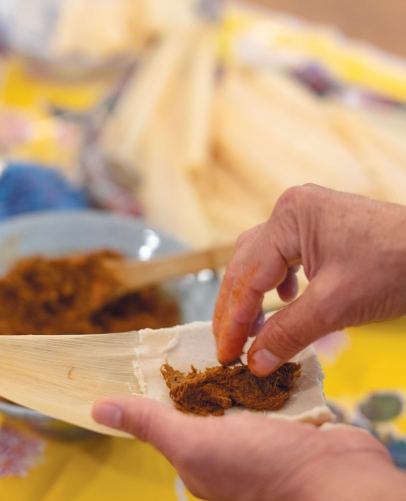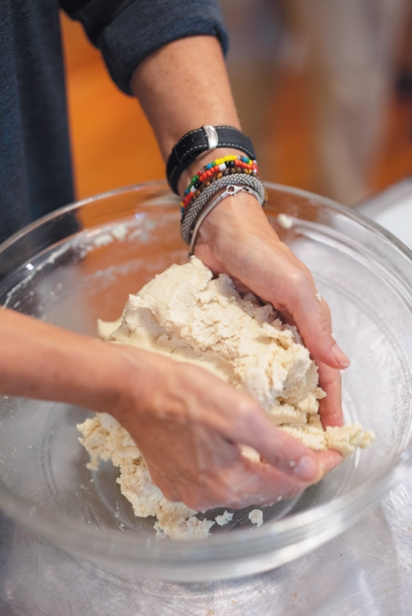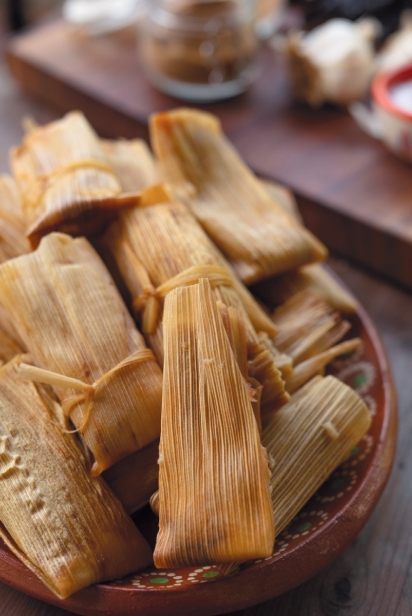Making Tamales Takes More than Masa
A Time-Honored Food Tradition Keeps Lost Loved Ones Close at Heart
Jesús de la Torre holds a dried corn husk up to the window to see if he has thoroughly covered the wide (and smooth) part of it with just enough masa, the ground-corn paste that is the foundation for a tamal filling. He notices a couple of “holes” to patch, so he places it back in his palm and spreads a bit more masa on the husk.
“Drafty tamales are no good,” he says, with a rueful smile. “My sisters would be teasing me right now.”
Next, he adds the filling, with dollops of spicy pulled pork or refried beans, a bit of cheese and perhaps some jalapeño slices. Then he rolls the bottom of the husk around the filling and tucks the narrow husk tail up one side of the wrap. “Tamal,” after all, means “wrapped.”
In addition to the traditional pork tamales, de la Torre now often includes a few veggie ones, such as spicy sweet potato, a milder cream cheese and bean version, or just beans.
De la Torre has been making tamales since he was big enough to soak the corn husks (to make them pliable). Growing up in San Antonio, Texas, he learned the art of tamalmaking, along with his three sisters, from their parents, who had emigrated from Mexico. As was the custom, his family celebrated Christmas on Christmas Eve, and they spent that day wrapping scores of tamales and steaming them for their holiday feast.
“We usually did 15 pounds of masa and 30 pounds of filling,” de la Torre recalls. “Some families made huge tubs of masa dough. Even we had leftovers for days.
“We did all kinds of crazy things,” he continues. “My mom used to grind the red chilies in a molcajete [mortar and pestle] to make the sauce for the pork; when she became bedridden, my wife, Sarah, suggested we use the blender. Alas, there was no top on the blender, and we had chilies on walls and curtains—everywhere!”
That kind of story—including the year de la Torre’s father found some cream cheese in their fridge to pair with jalapeño peppers simply to finish off the amount of husks and masa they had left—is told year after year, during the tamal-making. (The unusual filling is now a family favorite.) Since the tamal-making is accompanied by music and Margaritas, the tales might tend to get taller, the laughter more raucous and the tamales a bit fatter.
“This is really a mestizos dish,” de la Torre explains. “The Native Americans in Mexico used lime powder to cook the corn, so that they could grind the hard shell off the kernel. The Spanish brought in lard, which is added to the ground corn, along with a bit of salt, baking powder and liquid, and then the masa is vigorously kneaded to a spreadable consistency.”
Making tamales was always more than a one-day process for de la Torre and his San Antonio family. The sauce for the pork and the pork itself, as well as the beans, could be cooked a few days ahead. And the assembly of the tamales fell to the siblings according to age and experience. First the husk-soaking; then the stripping of ribbons from the husks to tie around the spicy tamales; then, eventually—”like grad school,” quips de la Torre—the spreading of the masa along the bottom half of the husk.
De la Torre kept making tamales, with family or friends, after his parents had passed away, because he wanted his daughters to “know my parents through the things they taught me.” He started doing tamal-making workshops in San Antonio, where he was starting his own family (he just moved to Rhode Island four years ago and is a teacher in the South Kingstown school system). “I thought, ‘I can’t be the only person out there who has lost someone and wants to keep the traditions,’” he remembers.
So he organized the workshop at a restaurant and 100 people showed up! They told them about their grandmother or their aunt or their mother and he knew that he was “giving them back those people through making the food.”
Realizing that the tamal tradition goes back thousands of years to when the tiny wild corn was cultivated and that a Mayan mural shows tamal-making in the year 700, de la Torre kept doing the tamal workshops and handing out his mother’s recipe (as he and his sisters had re-created it). And, they tell the stories once again.
“So a lot of people have known my mother and father even though they never met them,” he says. “It’s a beautiful kind of thing because it connects me to my indigenous roots, to my parents, to my mestizo roots.”
And nowadays, at their home in Jamestown, where his wife, Sarah Harding, grew up, de la Torre loves making the tamales with their two daughters, Maya and Elijah. Both daughters have long since “graduated” to spreading masa and filling the corn husks. But, with Maya away at college in Vermont, it’s Elijah and Sarah who help to create the finished tamales with friends and visitors when tamal-making falls on days other than Christmas Eve.
“They’re a ceremonial food, a communal food,” de la Torre emphasizes. “We make them for all special events, such as the Day of the Dead, as well as Christmas. Tamales for me are much more than food—it’s the family connection and it’s something my daughters will always remember.”







